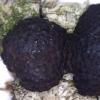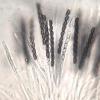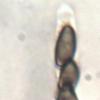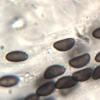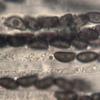
07-01-2026 17:29
 Marc Detollenaere
Marc Detollenaere
Dear Forum,On a barkless Populus I found some smal

10-11-2021 17:33
 Riet van Oosten
Riet van Oosten
Add-on topic http://www.ascofrance.com/forum/7059

07-01-2026 10:24
 Danny Newman
Danny Newman
Pezicula sp. on indet. hardwood Appalachian Highl

07-01-2026 10:05
 Danny Newman
Danny Newman
cf. Chaetospermum on XylariaCosby Campground, Grea

02-01-2026 17:43
MARICEL PATINOHi there, although I couldn't see the fruitbody, I

04-01-2026 17:45
 Stephen Martin Mifsud
Stephen Martin Mifsud
I was happy to find these orange asmocyetes which

03-01-2026 13:08
Niek SchrierHi all,We found groups of perithecia on a Lecanora
I found this stromatic fungus growing on the wood of _Castanea sativa_. The stroma is brown and exsudes a red pigment in KOH. The asci are very long
and thin, up to 150 x 6 µm, unitunicate, apically amyloid, and contain 8-spores each, uniserially arranged at the top. The spores are one-celled, hyaline when
young and soon brown, guttulate, with the following dimensions:
(6.7) 6.9 - 7.7 (8.1) × (3.3) 3.5 - 4.1 µm
Q = (1.8) 1.81 - 2.1 (2.2) ; N = 27
Me = 7.4 × 3.8 µm ; Qe = 1.9 ,
which are much smaller than my previous observations of similar fungi. Can someone help me in give it a name?
Thanks in advance,
zaca

it fits well Annulohypoxylon minutellum, formerly known as Hypoxylon cohaerens var. microsporum.
Jacques
The size of the spores troubled me.
Best wishes,
zaca
D'accord pour Annulohypoxylon minutellum mais le support m'intrigue. J'ai souvent récolté cette espèce mais toujours sur Quercus sp.
Amicalement
Paul
cheers
After the proposal of Jacques, I looked for more information about this species and in the description of Hypoxylon cohaerens at the webpage "Pyrenomycetes from southwestern France"
http://pyrenomycetes.free.fr/hypoxylon/html/Hypoxylon_cohaerens.htm
I found the following text that I quote:
"Notes: Hypoxylon cohaerens is a common saprophyte of beech forests, characterized by black pulvinate stromata constricted at base with papillate ostioles. Two other taxa, H. cohaerens var. microsporum and H. multiforme, share similar stromatal features, and field identification relies mainly on host identification: H. cohaerens is restricted to Fagus while H. cohaerens var. microsporum is restricted to Quercus and Castanea and H. multiforme grows mostly on Betula, Alnus and Corylus. However, one collection made on Ligustrum vulgare, a member of Oleaceae, [Hautes Pyrénées (65), Bagnères de Bigorre, L'Arbizon, 04 Sept. 2002, JF-02154, leg. FC] proves that host specificity is rarely absolute."
From it I infer that Castanea sativa is a common host for Annulohypoxylon minutellum (formerly known as Hypoxylon cohaerens var. microsporum, as Jacques mentioned). Am I wrong?
Best wishes,
zaca

Hi together,
what grows on Quercus also grows on Castanea. There is no fungus I know (mycorhizal or saprotrophic) growing with/on Quercus that does not grow with/on Castanea. Example: even the typical Castanea-fungus Rutstroemia echinophila can be found on Quercus leaves and cupules.
Regards from Lothar
Best wishes,
zaca




